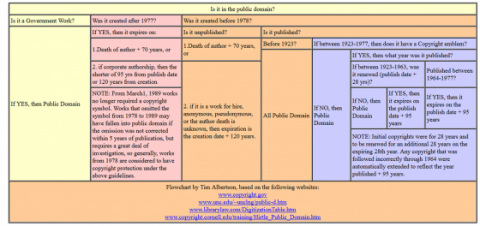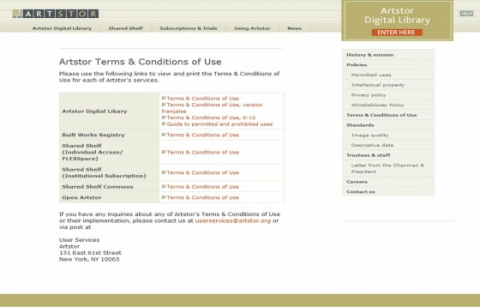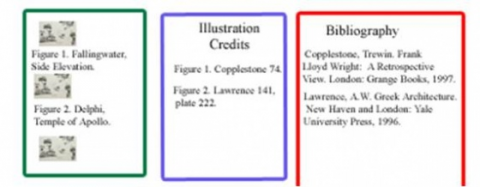Analysis of the Built Environment Library Assignment: Copyright and Citing
Part 1: Copyright
Why do students need to learn about copyright? In a word, the web. The web has changed the way we do things, including for instance, personal web pages and course web pages.
In the olden days, a student would include an image in a paper, credit the source of the image, and the legal ground was solid. Now, by putting it on the web in a course page, it is, in a sense, published. This complicates the legal landscape. In many cases, definitions set forth are up for interpretation and encourage discussion.
It must be noted that the copyright landscape is changing every year as more people interpret laws and different points of view are considered. So let's start with explaining, just a bit, what copyright is, and how it applied to student work.
Copyright is the legal provision for certain rights and restrictions regarding the use and reproduction of materials. Copyright law is an area of legal expertise.
The points made below should not be considered legal advice. They are simply an effort to draw out some relevant elements concerning copyright that students may find helpful.
Citing is an ethical practice. It credits the source of words or ideas, allows the reader to go back to the original material, and gives the writer credibility. If you did not formulate the image, words, or ideas yourself, then cite it.
The purpose of copyright law is said to be the encouragement of artistic and scholarly production by protecting the rights of the originator [or the publisher] to benefit financially now or in the future, for the period the copyright lasts. It also grants the originator [or the publisher] control over any future uses of the material.
According to Section 102 of Copyright Law:
Copyright protects original authorship fixed in tangible form (17 USC sec. 102(a)). Under U.S. law, copyright protection subsists from the time the work is fixed in any tangible medium of expression from which it can be perceived, reproduced, or otherwise communicated, either directly or with the aid of a machine or device. Copyright registration is not mandatory, although it has benefits.
This information applies also to works accessed via network (websites, text, etc.) and files and documents transmitted and/or downloaded via network.
For works transmitted online, the copyrightable authorship may consist of text, artwork, music, audiovisual material (including any sounds), sound recordings, etc. Copyright does not protect ideas, procedures, systems, or methods of operation (17 USC sec. 102(b)).
And what about public domain? Not everything is under copyright. All materials published by the federal government are NOT under copyright.
For other works, it depends on if the work was published and where, and when it was created. The standard period now for copyright is for the life of the creator plus 70 years, but this may be extended.
Once a work is no longer covered by copyright, it is said to be in the public domain. Public domain basically means you can use the work without permission of the creator and without paying a fee for the use.

See chart large size: module_9_copyright_chart.doc
What is fair use? Although the law seeks to protect the interests of the author and/or publisher it also purports to balance that protection with provisions allowing what is called "fair use," recognizing that free exchange of ideas is necessary to forward research and teaching.
Under the fair use doctrine of the U.S. copyright statute, it is permissible to use limited portions of a work, including direct quotes, for purposes such as commentary, criticism, news reporting, and scholarly reports. There are no legal rules permitting the use of a specific number of words, a certain number of musical notes, or percentage of a work.
Section 107 contains a list of the various purposes for which the reproduction of a particular work may be considered "fair," such as a criticism, comment, news reporting, teaching, scholarship, and research. Section 107 also sets out four factors to be considered in determining whether or not a particular use is fair:
- the purpose and character of the use, including whether such use is of commercial nature or is for nonprofit educational purposes;
- the nature of the copyrighted work;
- amount and substantiality of the portion used in relation to the copyrighted work as a whole;
- the effect of the use upon the potential market for or value of the copyrighted work.”
All 4 of these factors must be considered together. For instance if the use was educational, but a big profit was to be made, the use would probably not be considered “fair.”
According to Section 107 of Copyright Law:
The distinction between ‘fair use’ and infringement may be unclear and not easily defined. There is no specific number of words, lines, or notes that may safely be taken without permission. Acknowledging the source of the copyrighted material does not substitute for obtaining permission.
Copyright protects the particular way an author has expressed himself; it does not extend to any ideas, systems, or factual information conveyed in the work.
The safest course is always to get permission from the copyright owner before using copyrighted material. The Copyright Office cannot give this permission.
When it is impracticable to obtain permission, use of copyrighted material should be avoided unless the doctrine of “fair use” would clearly apply to the situation. The Copyright Office can neither determine if a certain use may be considered ‘fair’ nor advise on possible copyright violations. If there is any doubt, it is advisable to consult an attorney.
Examples of Copyright Limitations Statements
Even assuming you wish to use an image for educational purposes (for example your class paper) you are not necessarily granted free use. One approach to determining if it is okay to use an image is to look to the source for guidance. Many web sites include additional copyright information that provides guidance on whether you can freely use their materials.
Here is an example from the University of Denver :
"You may use the digital images and catalog records found on the University of Denver Web site for private study, scholarship, or research.
If you wish to publish or reproduce the materials in any physical or digital form or use them for any commercial purpose, including display or web page use, you must obtain prior written permission from the University of Denver." Accessed 03/06/2015
How might this statement be interpreted? There seems to be no problem if you are going to use it for private study. However to reproduce the image on a public web page you must get permission, even though it is not for commercial use.
Another example, from the University of California Berkeley 's Architecture Slide Library [accessed 03/06/2015] reads a bit differently, although there are many similarities. It is more specific than the University of Denver statement, more limiting and could be interpreted as circumventing fair use provisions of the copyright law.
"Digital images in SPIRO are surrogate representations of real photographs, slides, and drawings. U.S. government images and images published prior to 1921 are most likely in the public domain, and may be available for use without further permission. All other digital images in SPIRO probably represent copyrighted works. You may use copyrighted works for education, scholarship, and criticism without securing the permission of the copyright holder. This means you may download images for classroom projection, unpublished papers, and personal uses only. All other uses, especially publication and sale require written permission of the copyright holder. Publication of Architecture Visual Resources Library images in any form, such as in dissertations, theses, personal and course web pages is not permitted without the expressed written permission of the copyright holder. Papers written in fulfillment of class assignments are not considered publications."
A “controlled access” site or “password protected” site limits access and therefore lays an argument that the use is fair, only for the purpose of the limited number allowed access. For example, Dr. White’s website is password protected. Access is limited to the students in the class. This can be interpreted as fair use for educational purposes. However, educational use also can be compared to that of displaying a project in the hallway for a studio presentation. If this was on a public site of the world wide web, everybody in the world has a chance to see the information contained and it can be argued that this is no longer just a class project, or for private, educational use. Depending on interpretations and guidelines set forth, these images and data may or may not be considered fair use.
How do you define “private?" The University of Denver distinguishes between public and private use. The University of California distinguishes between educational and commercial use, but also between print student papers and course web pages. Denver and UCB “see” permissible in two different ways. The copyright laws, and fair use, are subject to interpretation! Should something not be considered fair use just because the University of California forbids students to post information to a course restricted website?
With print materials there is no additional guidance concerning restrictions. By examining copyright statements on web sites, however, you start to develop a sense of what is permissible. If the work is in the public domain, then it can be freely used [see the chart above]. If it is not in the public domain, then use is subject to the rights and restrictions of the copyright law.
What images can you use in your paper, and on a web site, according to copyright?
- Use of an image in a class paper is fairly simple. It is allowed as a fair educational use.
- Use of an image on a class web site is not simple, especially if the site is not password or otherwise protected from access. Here are some questions to ask:
- Is the image in the public domain? In addition to the materials identified as in the public domain above, images that are part of our common view of the world can be considered in the public domain. An image of a stop sign is in the public domain.
- Can your use of the image be defended as fair use? Use of an image for educational purposes, on a protected web site, could possibly be defended as “fair use.” If there is specific prohibition against such use [as with the University of California Berkeley slide library restriction], you will want to seriously consider the restriction in light of the law’s fair use guidelines.
- Is there any additional restriction, such as a contract, impacting use? For instance, libraries may purchase a license to an image database, with the provisions of the license forbidding any posting of their images to a web site. In this case the license or contract is the determining factor.
- An example of this is the image database ARTstor, to which the UNLV Libraries has subscribed. ARTstor has listed the terms and conditions for use of images from the database on its website. Note the categories of use that are covered in the conditions of use below.

- Is the image free? Or can the image be used upon payment of a fee? Some sites require a fee for use of their images. Others provide images for free, but there are often restrictions. For example the Fotor clip art site [accessed 03/06/2015] clearly states their expectations of use.
- What is the quality of the image? Is the quality of the image being posted to the web site such that it will have no impact on the current or future revenue of the author and/or publisher? Thumbnails have been determined to constitute no danger to revenue: they are of limited use due to their size and quality, thereby not affecting real or potential revenue.
- What about architecture and copyright? Although architectural drawings and models are subject to copyright, once the building is built and in the public view photographs can be taken without permission of the architect. However the photographs are then under copyright, with permission to use the photograph being the purview of the photographer.
- Can you get permission? Don't forget that this is one way to enable use of an image.
How can I find out who owns a copyright? First, check for the creator’s name alongside the Copyright Symbol. The US Copyright Office can provide you with the information available in their records. A search of registrations, renewals, and recorded transfers of ownership made before 1978 requires a manual search of the US Copyright files. Upon request, the US Copyright staff will search records at the statutory rate of $150 for each hour. There is no fee if you conduct a search in person at the Copyright Office. Copyright registrations made and documents recorded from 1978 to date are available for searching online.
Still have Copyright specific questions? Have a look at copyright.gov
For further reading on copyright, see the Copyright Crash Course materials at the University of Texas or "The Digital Difference: Responsible Conduct of Research in a Networked World by Richard Fyffe and Scott Walter (University of Kansas Graduate School , 2005). (.pdf file, 65 pages, select "view/open") (accessed 03-06-2015)
Copyright information provided by UNLV
Part 2. Citing Images
How do you give proper credit for an image? Just as for books and articles, the principle is that you note who is responsible, the title of the item, and where you found it. Images from web sites should also give the date accessed, since the web is a fluid environment. This can be indicated in a "caption" under the image. Sometimes you may have to supply the title. Sometimes you may not know the photographer.
The following would, typically, be included in a paper:

- Caption – What is it an illustration of? Provide a title and if you have an "illustration credits page" then include a figure number, e.g. Figure 1.
- Illustration Credits – Provide the Figure # and a brief source (e.g. author and page number). The source information must take you to one, and only one item in the bibliography.
- Bibliography – List of sources, alphabetized by author, with complete bibliographic information.
Below are five examples of caption, illustration credits, and bibliography.
Example 1. An illustration from a book as a source:
Caption: Figure 1. Fallingwater, Side Elevation.
“Illustration Credits” entry:
Figure 1. Copplestone 74.
“Bibliography” entry:
Copplestone, Trewin. Frank Lloyd Wright: A Retrospective View. London: Grange Books, 1997.
Example 2. A plate from a book as a source of illustration :
Caption: Figure 2. Delphi, Temple of Apollo.
“Illustration Credits” entry:
Figure 2. Lawrence 141, plate 222.
“Bibliography” entry:
Lawrence, A.W. Greek Architecture. New Haven and London: Yale University Press, 1996.
Example 3. Website image as a source of illustration:
Caption: Figure 3. Fallingwater - Main House South Elevation.
“Illustration Credits” entry:
Figure 3. Western Pennsylvania Conservancy.
“Bibliography” entry:
Western Pennsylvania Conservancy. “As Built Drawings for Fallingwater.” n.d. https://fallingwater.org/history/preservationcollections/research/architectural-drawings/. 06 Mar. 2015.
Example 4. Image Database as a source of illustration (ARTstor has a procedure that
involves saving the selections as citations and then the user has the option of emailing, exporting
directly to a bibliography programs, or printing the citation information out):
Caption: Figure 4. Fallingwater.
“Illustration Credits” entry:
Figure 4. Wright #ARTSTOR_103_41822000219848.
“Bibliography” entry:
Wright, Frank Lloyd. Bear Run: Fallingwater: Ext.: From Below Waterfall in ARTstor,
#ARTSTOR_103_41822000219848. https://library.artstor.org/asset/ARTSTOR_103_41822000219848. 06 Feb. 2015.
Example 5. JStor journal article as a source of illustration (follow the normal citation rules
for scholarly articles with the addition of the JSTOR article URL):
Caption: Figure 5. Fallingwater.
“Illustration Credits” entry:
Figure 5. Mims 19.
“Bibliography” entry:
Mims, Sandra K. “Experiencing Architecture: Teacher Residency at Fallingwater.” Art Education (January 1993):
19-25. https://www.ezproxy.library.unlv.edu/login?url=https://www.jstor.org/stable/3193416
PRINT OUT AND TAKE THE QUIZ. Be sure to include your name, date, and course section.
Quiz file: module_9_quiz.docx

